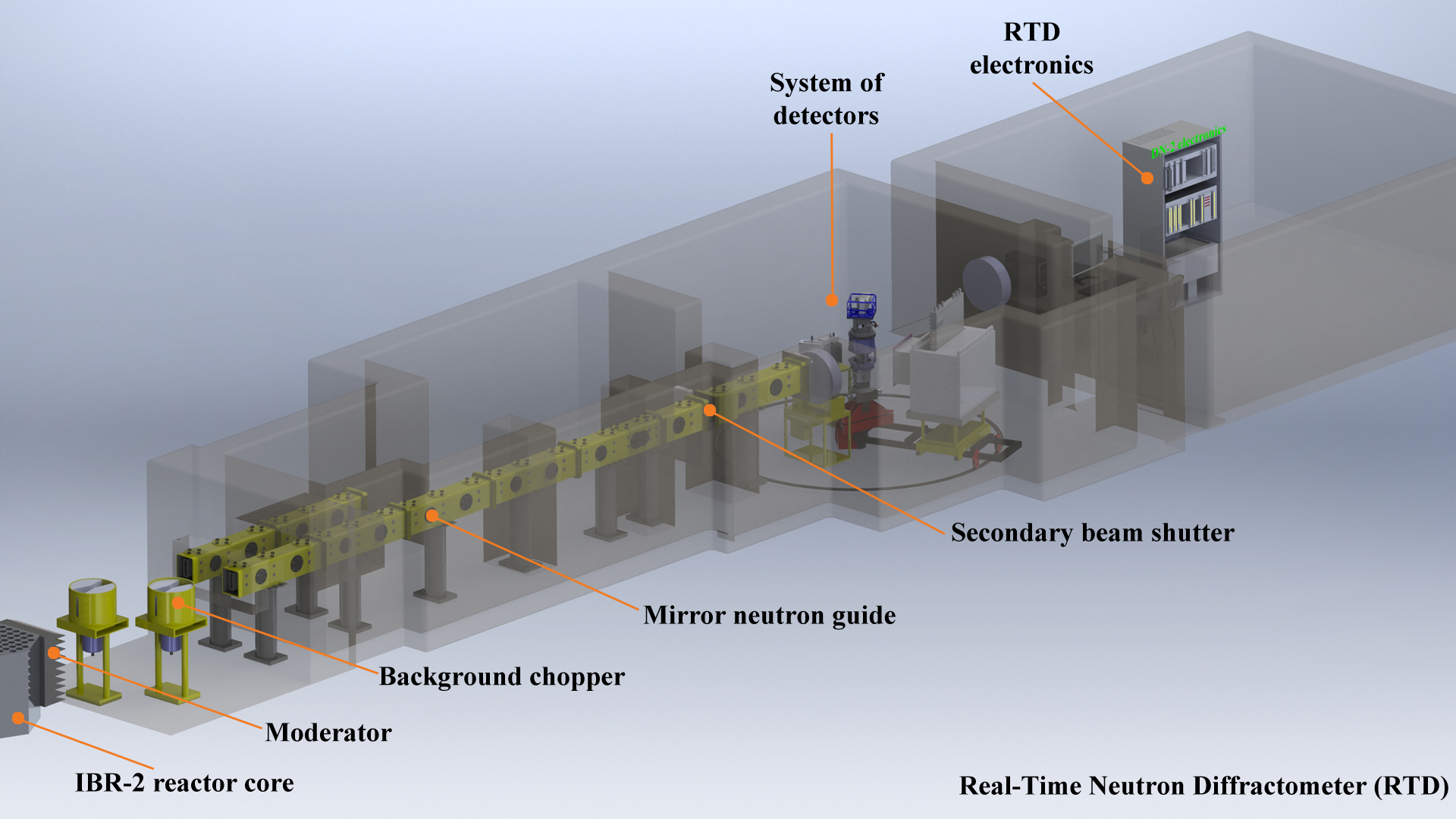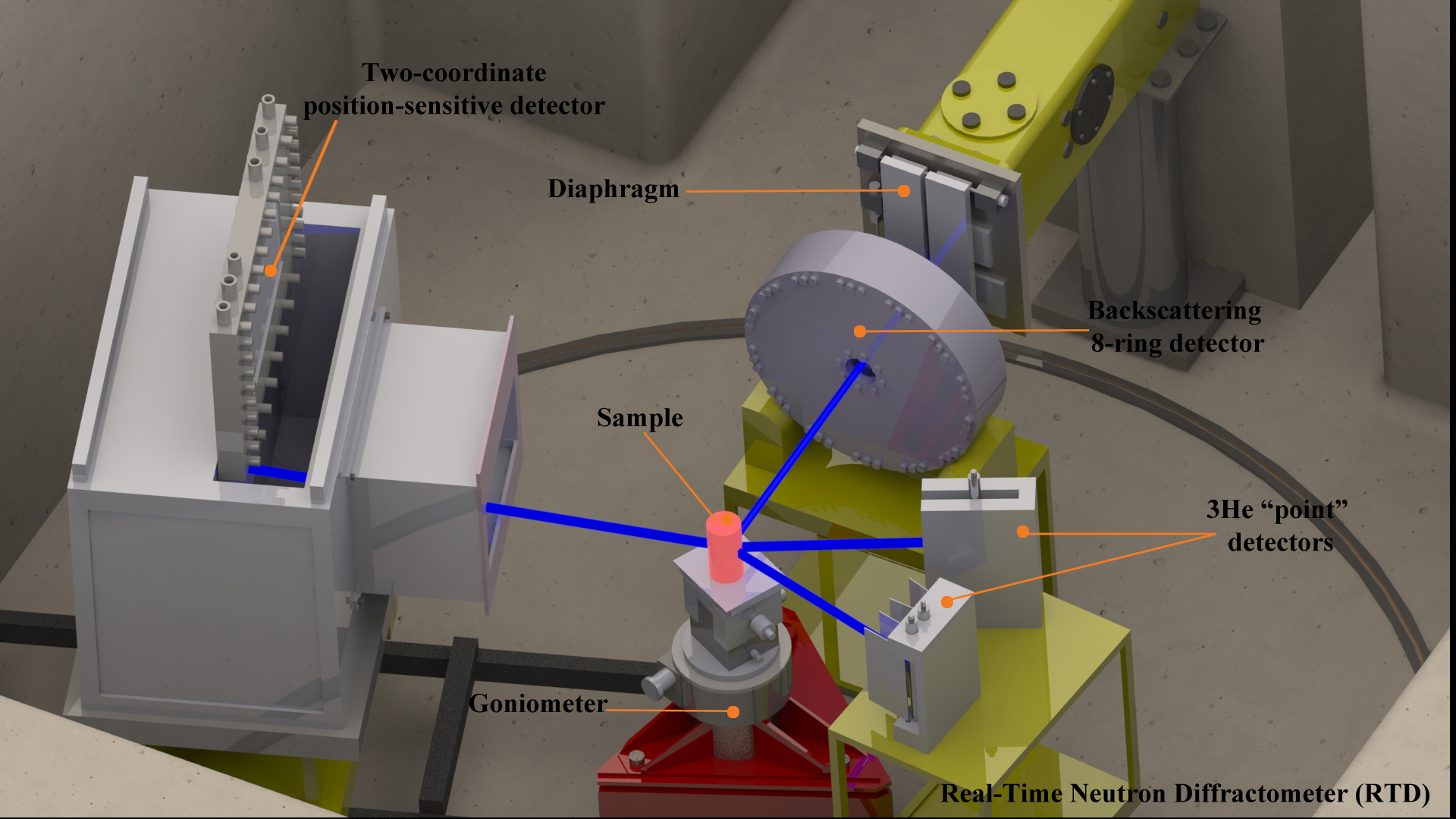Real-Time Neutron Diffractometer (RTD)
Responsible for the facility
tel. +7 (49621) 6-63-89
Main research areas
1. Analysis of the crystalline and magnetic structures of functional materials in a wide temperature range from 2.5 to 1400 K.
2. Investigation of solid-phase chemical reactions, crystallization, hydration and dehydration processes, kinetics of structural and magnetic phase transitions in real-time mode.
3. Peculiarities of crystalline and magnetic structures: diffuse scattering in defective crystals, low-dimensional structures with a large unit cell, incommensurate modulated crystalline and magnetic structures, domain structures, low-intensity superstructural reflections and others.
Description of RTD
Neutron diffraction is a widely used instrument for investigating the crystal and magnetic structure of functional materials, as well as its variation processes under external impact (for instance, temperature, electric and magnetic fields and others). The Real Time Diffractometer (RTD) is an operating experimental facility based on the DN-2 diffractometer on beamline 6a in the experimental hall of the IBR-2M pulsed reactor. The main advantage of the RT diffractometer is its high luminosity (of the order of 5×106 n/cm2/sec), a wide range of available wavelengths from 1 to 18 Å and a set of conventional and position-sensitive detectors for registering diffraction spectra from small to reverse scattering angles. All these advantages allow to accumulate data in the range of interplanar distances from 0.6 to 300 Å and to determine the crystalline and magnetic structure on polycrystals and single crystals.
The combination of the average resolution of the diffractometer with respect to the interplanar distance (~0.01) and the high neutron flux on the sample allows to use it for investigating the peculiarities of diffuse scattering of defective crystals, low-dimensional structures with large unit cells and low-intensity superstructure reflections, as well as incommensurate modulated magnetic structures and domain structures. A special advantage of RTD is the possibility of registering the processes of crystallization, hydration and dehydration occurring in condensed media, solid-phase chemical reactions, as well as the kinetics of structural and magnetic phase transitions in real-time mode. Such experiments are possible due to the minimum time interval for which the required statistics are gained.
In the moderator, a pulse of thermal neutrons is produced from fission neutrons. To overlap the continuous flow of background neutrons between flashes, a chopper is installed, the rotation frequency of which is synchronized with the frequency of neutron bursts. After the chopper, the neutrons enter the curved mirror neutron guide. The neutron guide is mounted in an evacuated steel casing and transports a beam of slow neutrons multiply reflected from its walls to the sample under investigation. Fast and short-wavelength neutrons are not reflected from the mirror walls of the curved neutron guide, they pass through its walls and are absorbed in the biological shield. A shutter is installed in the gap between the curved part of the neutron guide and its final straight section, with the help of which the neutron beam is blocked to provide safe access to the experimental hall. A diaphragm is mounted on the output flange of the straight section of the neutron guide that allows to set the required position and size of the neutron beam vertically and horizontally at the place where the sample is positioned.
The complex of detectors includes:
- ring backscattering detector that possesses eight rings, independently registering neutrons at large scattering angles;
- three units of eight helium counters that can be positioned at different angles depending on the objectives of the experiment;
- a small-angle ring detector with nine independent registering rings, each of which is divided into 16 separate sections that provide registration of the azimuthal asymmetry of small-angle scattering;
- position-sensitive two-coordinate detector 225x225 mm2, mounted on a swivel arm that allows to change the angle and distance of the detector relative to the sample.
To eliminate the background, the detectors are equipped with neutron-absorbing collimated screens.
The test sample or a refrigerator or a furnace with the sample is installed on the goniometer.
Main characteristics
| Neutron guide | Ni, mirror |
| Transverse dimension of the neutron guide | 15 mm × 180 mm |
| Moderator - sample distance | 23.78 m |
| Sample - detector distance | 0.15 - 2.0 m, variable |
| Neutron flux on the sample | ~ 5x106 m/cm2/c |
| Wavelength range | 1.2 - 18 Å |
| Scattering angle range | 1 - 170° |
| Interplanar spacing range | 0.6 - 300 Å |
|
Diffractometer resolution (Δd/d) : θ = 80°, d = 2 Å θ = 10°, d = 60 Å |
1% 10% |
Sample environment
- Cryostat based on a closed-cycle helium refrigerator Sumitomo with a temperature range from 2.5 K to 350 K.
- Furnace with vanadium heat shields for temperatures from 290K to 850K.
- Muffle furnace up to 1400 K for experiments with registration at reverse scattering angles.
- Muffle furnace up to 1400 K for small angle scattering experiments.
- Liquid thermostat for the investigation of biological samples. Temperature range - from room temperature to 90°C with humidity control.
- Triaxial goniometer.
- Reactor for real-time investigation of chemical synthesis products in solutions in the temperature range from 290 to 370 K;
- Linear displacement device on 6 samples for a programmable sequence of their installation in a working position at room temperature.
References
- A. M. Balagurov, A. I. Beskrovnyy, V. V. Zhuravlev, G. M. Mironova, I. A. Bobrikov, D. Neov, S. G. Sheverev / Neutron Diffractometer for Real-Time Studies of Transient Processes at the IBR-2 Pulsed Reacto // J. Surf. Invest. X-ray, Synchr. Neutr. Techniq. 10(3) (2016) 467-479.
- A.I. Beskrovnyy and Z. Jirák. Structural modulation in Bi2Sr2Ca0.4Y0.6Cu2O8+d . Journal of Physics: Conference Series. V. 340, (2011) P. 405-410.
- Jażdżewska M., K. Domin, M. Śliwińska-Bartkowiak,, A.I. Beskrovnyi, D.M. Chudoba, T.V. Nagorna, K.Ludzik , D.S.Neov. “Structural properties of ice in confinement” Journal of Molecular Liquids, 283 (2019) 167-173.
- A. Vl.Andrianov, E.Mendive-Tapia, A. I.Beskrovnyi, J. B.Stauntonl/ Collapse of the magnetic phase diagram of the elemental terbium Under strain-induced Lifshitz transition //Phys. Rev. B 104(17) (2021) P.174435.

